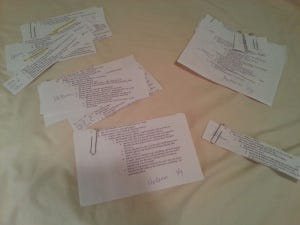An Outline's Not a Contract, Part One
When in doubt, reach for a scissors and paper clips. Maybe.
This post is part of the Outline With Me series. For more like this, check out the outlining your novel page.
An outline's not a contract, but it's very nice.
All joking aside, one of the more daunting aspects of writing a novel (aside from actually writing it) can be trying to develop and maintain some sort of organizing structure to guide us through the process.
It's no wonder so many people turn to making it up as they go.
Don't get me wrong; there's nothing wrong with flying blind through a first draft, but as the simple existence of the Outline With Me series might suggest, I'm a consummate planner.
That's not to say, though, that my strategies for outlining haven't changed over time, or that I've forced myself to stick to those outlines as new ideas struck during the writing process. On the contrary, I've used a different outlining strategy for all three of my completed manuscripts.
With that in mind, I thought I'd walk through the different structures and strategies I've employed for each, with an exploration of their individual pros and cons. We'll take them one at a time over the course of three individual posts.
The Paper Trail
My first manuscript (The Fugue) was based entirely on an M. Night Shyamalan-esque plot twist, which meant working backward from that moment and toward the beginning. That also meant a great deal of chaos, as I was in way over my head as a first-time novel writer—not that I knew that at the time.
Though the story itself was told only from the perspective of the protagonist, I outlined the manuscript's husk of a plot from the perspective of all its major players, as I wanted to at least make an attempt at including growth arcs of one kind or another for each.
Once I had every character's individual "plot" outlined, I then printed each and took a scissors to individual moments (a.k.a beats) before rearranging them chronologically against the snippets cut from the outlines for my protagonist and the other supporting cast members. The end result left me with something like this:
Looks pretty chaotic, right? That's because it was. Despite the appearance of the above, however, it did actually have some advantages (kind of), which we'll explore below.
Pros
One of the primary advantages to this system was that it slowed me down. I had to really take my time to consider what went where, rather than being able to type and digitally cut and paste at a million miles a minute.
In theory, the Paper Trail approach should have have given me more opportunities to spot plot sag or points for greater tension, but I didn't have a strong enough writing background at the time to recognize those weak areas as I encountered them (first novel, remember?).
Another advantage to this system was that it helped me get a bird's eye view of the entire plot from the perspective of the novel's major players. In this way, I was able to spot when a character and the subplot(s) of which they were a part disappeared for too long in the overall flow of the action.
On top of this, I had the opportunity to see when it was to the story's benefit to create settings that fostered the interaction of multiple characters and storylines.
Cons
The obvious disarray of scraps and paper clips left me failing to see the story's major pacing issues. This led to far more rewrites than may have been necessary had I used a more easily navigable outline that better cast light on the low-stakes, claw-your-way-through-purple-prose action of, well, the entire draft, really.
Another concern more tied to the plot-twist-centered approach than to the outline itself was that I ended up with a manuscript full of characters making inorganic decisions to push the action toward the Big Reveal. That is to say, characters did things not because it's what they would have done, but because I as the author wanted them to be doing them.
As is covered in a number of other posts, the overt imposition of the will of the author often stirs readers from the narrative dream, which can have them snapping our books closed in a hurry.
Summary
Ultimately, I abandoned this outline approach in favor of something with a deeper structure for my more recent manuscripts. That's not to say that the Paper Trail approach is without merit, however.
There's definitely an advantage to being able to have a physical copy of the outline in your hands, especially if you're able to rearrange it on the fly as you see fit. In this way, it offers both tangibility and flexibility, without the need to jump from one tab or one application to the next on your actual writing interface.
Part two of this three-part mini-series will focus on the use of beat sheets, which I used when writing the earliest drafts of EMPATHY, so stay tuned!







